Samsung Galaxy Tab S Review (10.5 & 8.4-inch)
by Anand Lal Shimpi on June 24, 2014 9:00 AM EST- Posted in
- Tablets
- Samsung
- Mobile
- Galaxy Tab S
Display
In addition to the dramatically reduced chassis thickness, the move to a Super AMOLED display is the other flagship feature of the Galaxy Tab S lineup. Both devices feature a 2560 x 1600 Super AMOLED panel. The 10.5-inch model features a derivative of the S-Stripe RGB subpixel layout and geometry we first saw in the Galaxy Note 2.
Each pixel features loosely spaced red, green and blue subpixels, with the latter being a thin strip in comparison to the more traditional rectangular red and green subpixels:
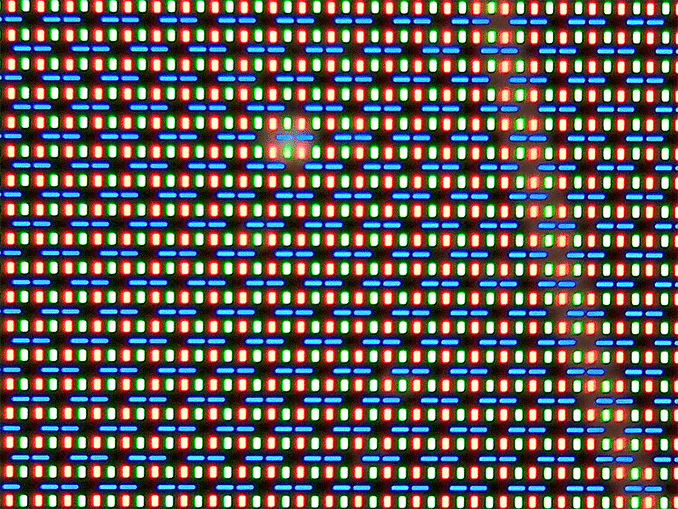
Samsung Galaxy Tab S 10.5, S Stripe RGB
Choosing different geometries for the blue subpixels makes sense as they have lower luminous efficiency than their red and green counterparts. Through balancing of subpixel size and drive power this design should allowed for equal luminance among all three subpixels. The uneven spacing is something new for the Galaxy Tab S 10.5, as the design looked far more structured back in the Note 2 days.
The 8.4-inch model by comparison uses a diamond PenTile RG,BG layout:
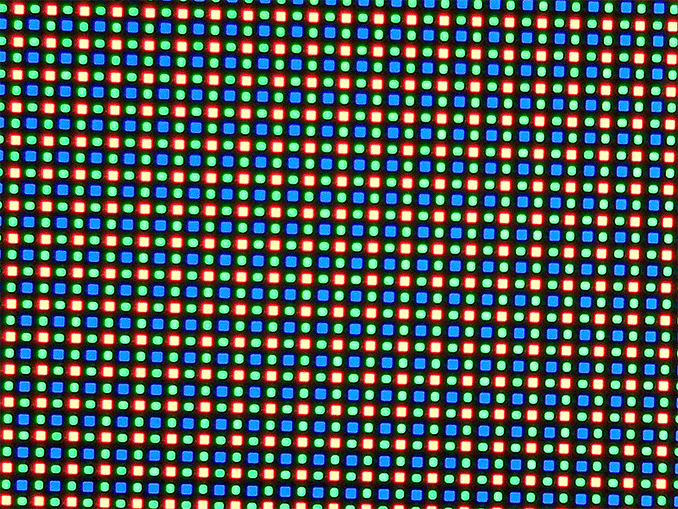
Samsung Galaxy Tab S 8.4, Diamond PenTile
This is similar to what we saw on the Galaxy Note 3, and just like before you get two subpixels per unit pixel instead of three in a traditional RGB stripe. Thankfully the pixel density on the Galaxy Tab S 8.4 is high enough that I wasn’t able to discern individual pixels or be bothered by the diamond PenTile layout. I will admit that I’ve never been the most sensitive to PenTile or PenTile-like sub pixel arrangements, so your mileage may vary.
With the Galaxy S5, Samsung finally delivered a reasonably accurate out of box display calibration as an option. In bringing AMOLED to its tablet lineup, I wondered if Samsung would do the same here. Thankfully the answer appears to be yes.
The new displays have the same adaptive setting as the GS5, which adjusts display tint based on ambient light temperature. There are three predefined color settings, down from the five on Galaxy S5, if you prefer something a bit more predictable.
Although Cinema ends up being the most accurate on the GS5, AMOLED Cinema doesn’t get the same treatment on the Galaxy Tab S. It’s actually the new basic mode that most closely tracks with sRGB. The two AMOLED modes trade off color accuracy for more saturation. I ran our display suite through all of the modes on the Galaxy Tab S 10.5 to illustrate the difference:
| Samsung Galaxy Tab S 10.5 Color Profiles | |||||||||
| Average White Point | Grayscale DeltaE 2000 | Gamut DeltaE 2000 | Saturation Sweep DeltaE 2000 | GMB ColorChecker DeltaE 2000 | |||||
| AMOLED - Cinema | 7540K | 5.2572 | 6.8855 | 5.9306 | 7.0418 | ||||
| AMOLED - Photo | 6576K | 1.7425 | 4.8109 | 4.5933 | 3.3633 | ||||
| Basic | 6516K | 1.8378 | 2.8114 | 2.6195 | 2.4249 | ||||
| Basic (Galaxy Tab S 8.4) | 6294K | 2.3914 | 3.4564 | 2.7639 | 2.2186 | ||||
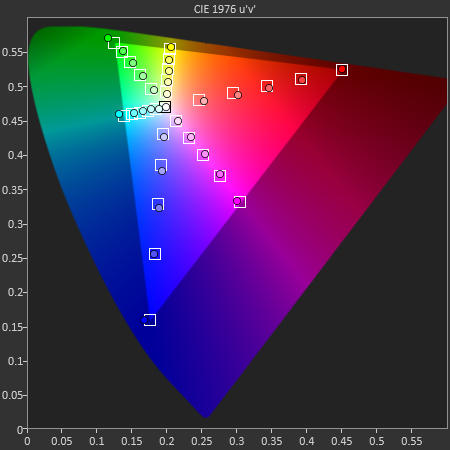
I’ve also included all of the CIE diagrams and test swatch comparisons in a gallery below if you want to have a closer look at what the AMOLED modes do. In short, both the photo and cinema modes oversaturate just in different ways. Photo appears to saturate evenly across all colors, while cinema mode compresses some while pushing out others.
As it’s the most accurate setting, I ran all of our comparison data with the basic mode enabled. In this mode the Galaxy Tab S’ display is among the best we’ve ever tested. On top of having good color accuracy, the new display delivers the awesome contrast ratio that AMOLED displays are known for. As you’ll see later on, there are definite power benefits as well when it comes to watching movies on these displays.
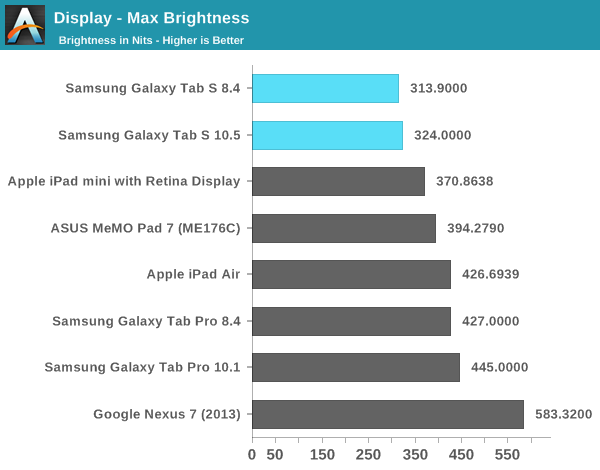
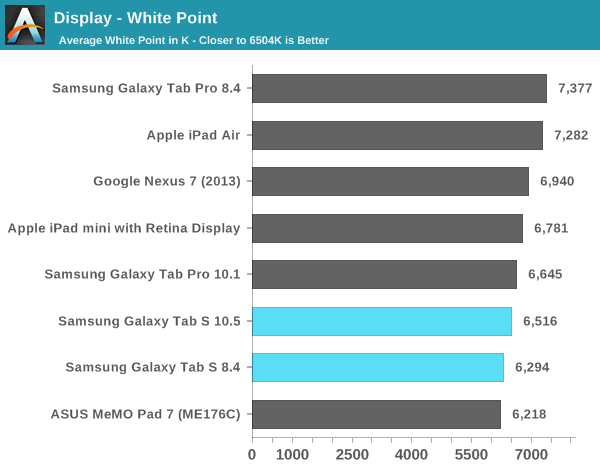
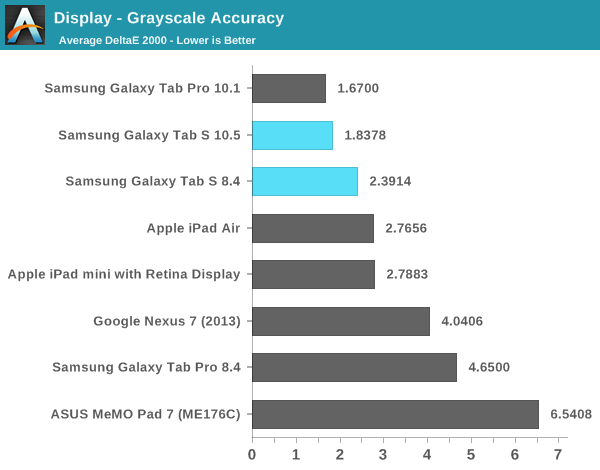
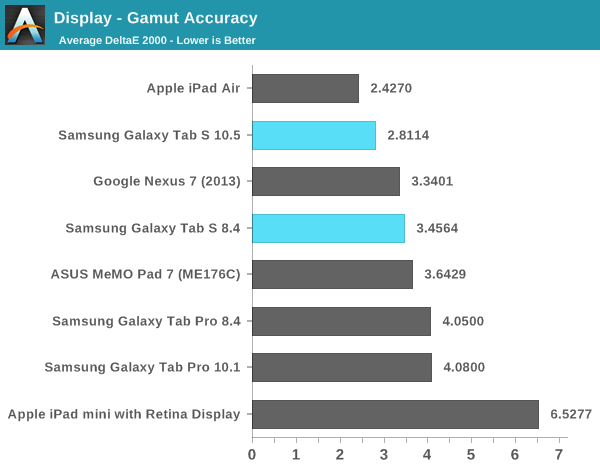

Samsung Galaxy Tab S 10.5 - Basic Profile

Samsung Galaxy Tab S 10.5 - Basic Profile

Samsung Galaxy Tab S 8.4 - Basic Profile

Samsung Galaxy Tab S 8.4 - Basic Profile
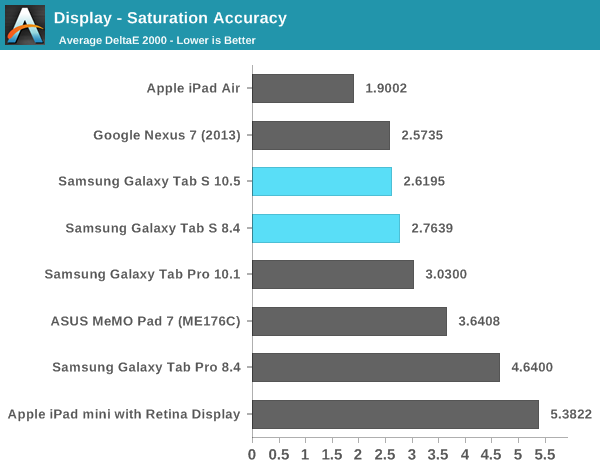

Samsung Galaxy Tab S 10.5 - Basic Profile

Samsung Galaxy Tab S 8.4 - Basic Profile
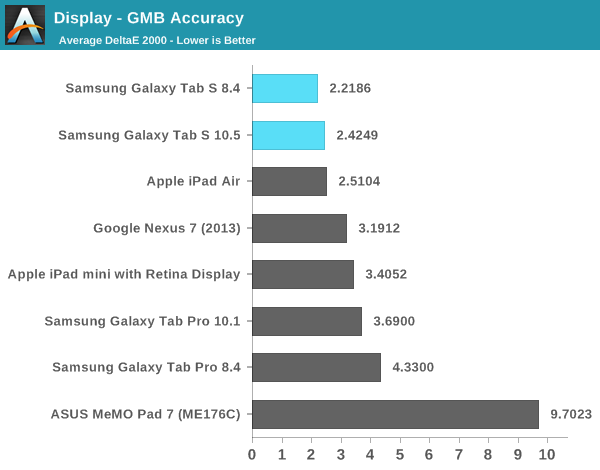
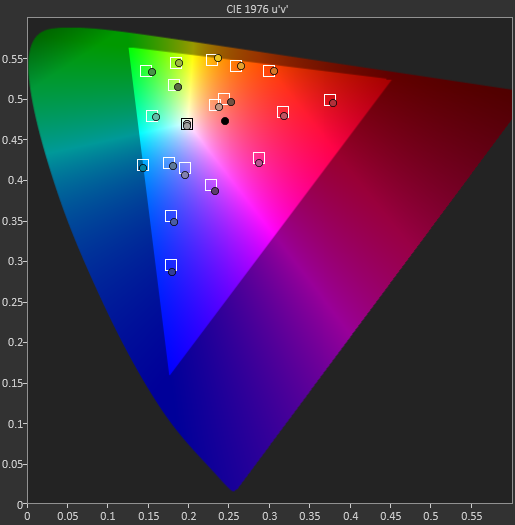
Samsung Galaxy Tab S 10.5 - Basic Profile

Samsung Galaxy Tab S 10.5 - Basic Profile

Samsung Galaxy Tab S 8.4 - Basic Profile

Samsung Galaxy Tab S 8.4 - Basic Profile


















98 Comments
View All Comments
antiglobe - Sunday, October 26, 2014 - link
I think the updated model will more likely use the new Exynos used in Galaxy Alpha than a Snapdragon. Samsung can obviously reach higher profits by utilizing home made chips.the_ether - Tuesday, June 24, 2014 - link
So if I've understood correctly, the Samsung's screen isn't that great after all - at least when compared against the iPad Air. It has more pixels and supposedly better contrast (though that wasn't tested here) but what is displayed is not as accurate as the Air's Retina screen.nerd1 - Tuesday, June 24, 2014 - link
AMOLED has immense contrast and no display lag, both of which are not tested here.GC2:CS - Tuesday, June 24, 2014 - link
The smallest amount of ambient light washes out any contrast difference, so you can enjoy your AMOLED at night, especially watching horrors but otherwise it's hardly a problem.What about that display lag ? Honestly I don't know what it is exactly, but I think is rather bad as I noticed flickering on many AMOLED displays...
nerd1 - Tuesday, June 24, 2014 - link
Smallest amount of ambient light will hamper any display color accuracy too, then all displays are born equal?the_ether - Tuesday, June 24, 2014 - link
Shouldn't be as sensitive as you imply. The screen is an emissive device, not reflective, so the ambient light would have to be strong enough to interfere with the light from the screen.theduckofdeath - Tuesday, June 24, 2014 - link
Hyperbole much, GC2:CS?dwade123 - Wednesday, June 25, 2014 - link
no lag huh. Nice BS.GC2:CS - Tuesday, June 24, 2014 - link
Yeah exactly ! The problem for samsung is that the iPad Air screen is the same as the screen of the new iPad (2012) just lower power and higher brightness... And this is 2014. Anand's numbers are painting these in a very good picture, but in reality I found this: https://m.youtube.com/watch?v=SjYuNzFRIagBlues are especially over saturated on the 10,5 just as that horrible sub pixel arrangement implies.
bji - Tuesday, June 24, 2014 - link
How can you possibly tell anything about a display when viewing a video of it on your own display, which completely alters the perceived characteristics of the display being evaluated?I have an idea. Let's film both displays in black and white and then do a comparison to try to see which display has better colors. It would be just about as viable a means of comparing displays as the video you linked.